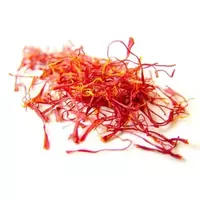Saffron

Saffron has been known to mankind since time immemorial, as many ancient sources say. He was presented as a gift to high-ranking persons, and they were ready to give an Arab horse for just a pound of this spice. Currently, only 300 tons of this spice are produced annually in the world, and its cost is equal to gold.
The word "saffron" comes from the Arabic "azafran, " which can be translated as "yellow. " Indeed, the stigmas of a flower called crocus are painted bright sunny after drying. Here are these stigmas and there is a delicious, but very expensive spice.
Saffron has strong aromatic qualities, so one gram will last you for a long, long time. For example, in order to paint three liters of water, you will need only two saffron stigmas. The aroma of this spice is revealed gradually, over 20-24 hours, so baking using saffron will be more fragrant the next day.
The benefits of saffron as a natural dye are invaluable in the preparation of dairy dishes, creams, sweet gravy, pastries, ice cream, jelly and mousse. For example, to color one serving of custard, you will need no more than 8 stigmas of this spice. The cream will acquire a bright golden color and exceptional aroma.
Saffron has such a peculiar smell that it is mainly used in dishes on its own, that is, without the admixture of other spices. But if you have a desire to experiment, keep in mind that it "coexists" well with cinnamon, thyme, basil, rosemary and cilantro. The calorie content of saffron is 310 kcal per 100 grams.
The benefits of saffron
In addition to great taste, people have long known the beneficial properties of saffron. It is widely used in the field of medicine, as a means to improve appetite and digestion, tones the body. In pharmacology, saffron stigmas are used in the manufacture of eye drops and various therapeutic tinctures. It is part of approximately 300 medicines of Eastern medicine.
Saffron is an invaluable treasure trove of vitamins and minerals. The benefits of saffron are manifested in the content of such macro and trace elements as: calcium, copper, iron, selenium, zinc and many other vital substances. After numerous studies, it was found that regularly eating this spice contributes to the restoration of not only body cells, but also the brain.
Saffron harm
When eating saffron, be careful, as large doses of the spice can lead to poisoning, and in some cases, to death. Saffron harm can affect a pregnant woman and her future child, as it is able to increase the tone of the uterus. Using the "king of spices" in minimal quantities and maintaining shelf life will save you from the likelihood of its harmful effects on the body.
saffron 310 kCal
Energy value of saffron (Ratio of proteins, fats, carbohydrates - ju):
Proteins: 11.43 g (~ 46 kCal)
Fats: 5.85 g (~ 53 kCal)
Carbohydrates: 61.47 g (~ 246 kCal)
Energy ratio (bj | y): 15% | 17% | 79%
 Español
Español Français
Français Português
Português Русский
Русский 简体中文
简体中文 繁體中文
繁體中文 日本語
日本語 한국어
한국어 العربية
العربية Türkçe
Türkçe Қазақ
Қазақ Deutsch
Deutsch Italiano
Italiano Українська
Українська
